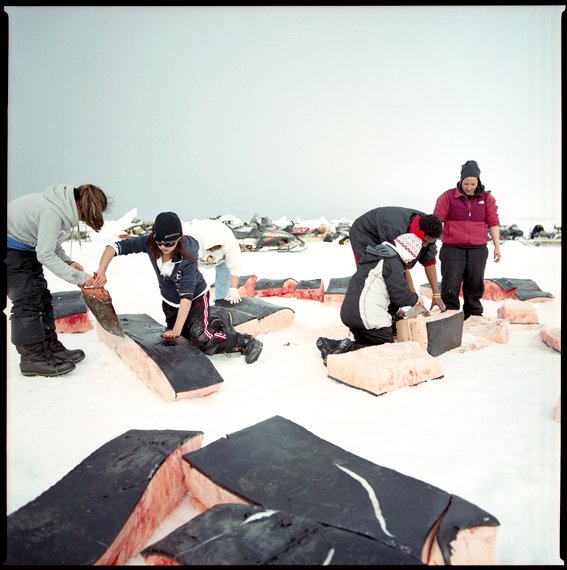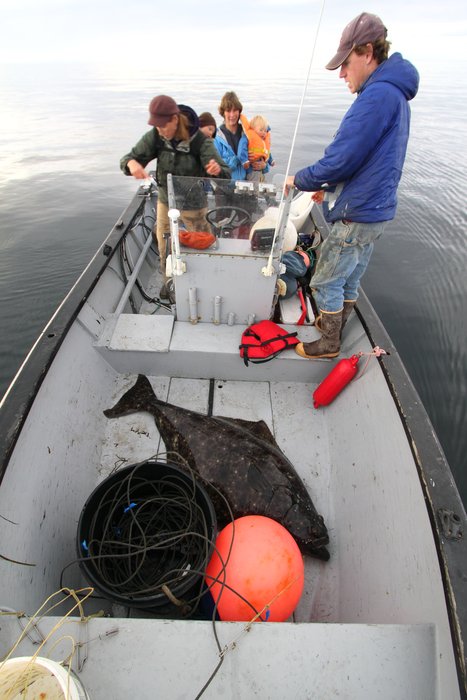
- Summary
- What is Subsistence?
- Subsistence in Alaska
- Changing traditions and diets
- Management and Regulation
Summary
The subsistence harvest of wild resources is important to the livelihood and culture of many Alaskans, both Native and non-Native. Subsistence harvests of fish and game represent a significant portion of the diet in rural Alaska, and are managed with a priority over other uses such as sport and commercial fishing.

What is Subsistence?
Subsistence is the term used to refer to the gathering of wild resources (usually food) for personal necessities. Through most of history all human beings survived by subsistence but much of mankind now has replaced these activities with the division of labor, specialization, and trade.
Alaskan and Federal law define subsistence similarly, as the “customary and traditional uses” of wild resources for food, clothing, fuel, transportation, construction, art, crafts, sharing, and customary trade. “Customary and traditional” therefore includes activities such as harvesting fish for food, as well as for example the collection of caribou antlers for traditional crafts.
Subsistence in Alaska
The subsistence harvest of food is an important part of life in Alaska, particularly in rural areas of Alaska, which includes 20% of the state’s population. In 1999 (the last year for which a statewide analysis of subsistence harvesting was done) rural Alaskans acquired 35% of their required daily calories from subsistence hunting and fishing. In western Alaska this number was 62%, and represented 664 pounds of wild foods per person. The Alaska Department of Fish and Game estimated that the market “replacement value” of the 43.7 million pounds of subsistence foods harvested in Alaska was $131-219 million in 1999.
A large number of plant and animals species are harvested in Alaska; statewide, 60% of the subsistence harvest by weight is fish, 20% is land mammals, and 14% is marine mammals, while birds, shellfish, and plants each make up around 2%. Though federal law normally prohibits the hunting of marine mammals, exceptions for subsistence use are permitted in Alaska for native Alaskans only. Various communities in the state therefore harvest seals, sea lions, otters, polar bears, walrus and whales.

In addition to nutrition and calories, subsistence is an integral part of the culture of many Native groups in Alaska. Subsistence is considered an important “socioeconomic activity” and has been legally recognized as such. Participation in subsistence activities is very high in almost all rural communities and sharing between more and less capable households is an important part of the sense of community. For example 83% of rural Alaskan households report being involved in the subsistence fishery, but fully 95% of rural Alaskan households report using fish from this harvest.
Changing traditions and diets
Though subsistence is focused on resources that have been used for millennia, modern technology now plays a big role. Guns, snow machines, ATVs, and motor boats all figure very strongly into subsistence hunting and fishing. Electric chest freezers are ubiquitous in most areas, making preservation much easier. Even current information technologies such as depth sounders, cell phones, and detailed charts, maps, and satellite photos have their uses in modern subsistence harvesting.
Consumption of subsistence foods in Alaska is also nowadays correlated strongly with the consumption of highly-processed and shelf-stable products such as soda, canned soup, and white rice. This means that many rural subsistence diets have for example high levels of protein and Vitamin A but often insufficient levels of fiber and calcium. These diets often also tend to be too high in fats and refined sugars. There are also worries about the levels of modern environmental contaminants, such as mercury and persistent organic pollutants, in a number of subsistence foods.

Management and Regulation
Because of the continued importance of wild food harvests in Alaska, subsistence users are given legal priority over sport and commercial users for both fishing and hunting. Subsistence in Alaska is managed by both state and federal authorities depending on where the harvesting takes place. The biggest difference between state and federal regulations is that the state recognizes all Alaskans as potential subsistence users and the federal government only recognizes rural Alaskans. In addition, the state and federal governments have agreed on “non-subsistence areas” in more densely populated areas, such as around Fairbanks, Anchorage, the Mat-Su valley and the Kenai Peninsula, where subsistence harvesting is prohibited. However, these areas have “personal use” fisheries that allow limited, subsistence-style, fish harvests (gill nets, fish wheels, etc.). Legal access to personal use fisheries in some of these areas is based on income.
Further Reading
- > Federal Subsistence Management Program website
- > Subsistence in Alaska: A Year 2000 Update by the Alaska Department of Fish and Game
- > Alaska Subsistence Salmon Fisheries: 2003 Annual Report by the Alaska Department of Fish and Game
- > "Subsistence Management Information: Informing Alaskans" webpage
- > Alaska Native Science Commission: Traditional Foods
- > Alaska Department of Fish and Game, Subsistence Division page
Created: Jan. 19, 2018